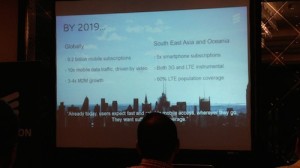

Eugene Sarmiento, Head – TV and Media Sales / Asia Pacific – Ericsson and
Elie Hana, President and Country Manager, Philippines and Pacific Islands – Ericsson
A couple of weeks ago, I attended the media briefing hosted by Ericsson regarding smartphone and data usage in Southeast Asia.
I haven’t been updated on these statistics since I left the telecommunications industry 3 years ago so I went to the event with great interest.
THE YOUTH
Okay, let’s start with this statement of Elie Hanna, President and Country Manager of Ericsson Philippines and Pacific Islands. “Youth are active users of apps, especially messaging apps, and in the Philippines, Indonesia and Malaysia nearly one-third of the population is aged 10-24. In these countries we also observe that the smartphone is the primary device for internet access and as smartphones become cheaper, more consumers will be able to enjoy the benefits of connectivity.”
This observation is not new to me. Thanks to local brands like Cherry Mobile, My|Phone and Starmobile, they were able to drive smartphone prices for as low as Php 1,690.00. The parents of these kids are easily convinced to buy them these low-cost smartphones, and if they get lost, at least they didn’t lose something with a very expensive price tag. “Hindi masakit sa bulsa pag nawala man ang cellphone sa ganung halaga.” (It’s not painful on my pocket to lose an inexpensive smartphone) – are the common remarks of parents I’ve talked to for the past couple of years about kids owning mobile phones.
Now here’s an interesting and quite surprising data (for me at least): in the Philippines, the youth (16-24 yrs old) comprises 60% of smartphone ownership compared to 53% for adults. I didn’t expect that kind of growth in a short period of time since 2013 where most smartphones released by the local players were priced below Php 8,000.00.
Another chart shows the weekly smartphone usage of the youth based in Indonesia, Philippines, Thailand, Malaysia Singapore and Australia. 70% of each country’s young smartphone users are into internet browsing, social networking and SMS. Meanwhile, the Filipino youth is comprised of 30-49% when using emails, instant messaging and video clips. I actually expected Instant Messaging and Video Clips usage to be at least in the 50-69% percent bracket because as far as I know, young people nowadays are into messaging apps like Viber, Line or WeChat and they love to watch and share videos too.
Filipino smartphone adult users on the other hand show more than 70% are still on SMS, 50-60% into social networking, 30-49% on internet browsing, email and instant messaging, and less than 30% on video clips.
SMARTPHONE GROWTH
Mr. Hanna thinks that there will be a huge growth of smartphone subscriptions by 2019. “Today, smartphone penetration ranges from around 20 percent for developing markets to more than 60 percent for advanced markets. As smartphone subscriptions are expected to grow about 5 times, there will be more than 700 million smartphone subscriptions in the region by 2019 and will constitute more than half of its expected 1.3 billion total mobile subscriptions.”
As usage of apps and services increases, naturally, mobile data traffic will grow by more than 10 times between 2013 and 2019. So I completely agree with Mr. Hanna’s statement: “This means there is a need to create high performing networks to keep up with more complex user demands and support increasing mobile data consumption.” I do hope our networks will do something about this.
Speaking of which, in 2013, 35% in Singapore, 25% in Australia and less than 5% in Malaysia are connected to LTE. The breakdown on the Philippines show 20% are on HSPA while 80% are still on GSM. On its, 8th year, I believe HSPA should have been bigger by now but majority of Filipinos prefer WiFi connectivity rather than be charged by their mobile network. They foresee LTE population coverage in South East Asia and Oceania will reach 60% by 2019.
I wish I can share more data but I haven’t read the other documents handed over to me due to lack of time. I’ll try to make another blog entry soon. Anyway, I hope you guys learned a few things about these data on smartphone usage.






